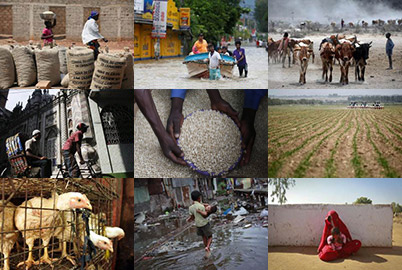Pakistan dykes and embankments weak, says UN
NEW DELHI (AlertNet) - Up to five million Pakistanis are at risk from floods this year, partly due to the inadequate rehabilitation of survivors still reeling from last year's unprecedented deluge there and poor reconstruction, the United Nations (U.N.) said on Wednesday.
Monsoon floods began roaring through Pakistan in late July last year, submerging one-fifth of the country – an area the size of Italy – and disrupting the lives of more than 18 million people.
The government and aid organisations were criticised for being too slow to respond while the military, widely seen as a far more efficient institution, took the lead in relief operations.
As Pakistan braces itself again for its annual monsoon season – which runs from late June to early September – the U.N. says authorities and the aid community have learnt lessons and are better prepared, even for the worst case scenario.
"Since the beginning of March, we have been in close contact with the government to make sure response is up and running and that we are better prepared this year," said Manuel Bessler, head of the U.N. emergencies office (OCHA) in Pakistan.
"The most anticipated scenario is two million (affected) and the worst case scenario is five million. We are prepared for these two scenarios," he told AlertNet by phone from Islamabad.
Last year's flooding – which went on for almost three months and wiped out villages from the far north to the deep south of the country – is considered to have been one of the worst humanitarian disasters in recent times.
Around 11 million people were left homeless, 2,000 were killed, infrastructure such as bridges and roads was washed away and millions of acres of crops destroyed.
POOR RECONSTRUCTION
Based on forecasts from the Pakistan Meteorological Department, this year's monsoons are, in general, likely to be 10 percent below normal.
Despite this, millions could be hit by floods, partly because infrastructure such as dykes and embankments were "weak" and could have been strengthened better, said Bessler.
A lack of funds has meant some communities affected by the 2010 floods have not been able to adequately reconstruct their homes or regain financial income after losing their livelihoods as farmers, making them more susceptible this year.
The U.N. last year appealed to the world for almost $2 billion to help survivors – the biggest appeal ever launched by the body for any humanitarian emergency. Yet, 30 percent of the appeal remains unfunded almost one year on.
"The vulnerabilities are higher this year than last year," Bessler said. "This is because of poor timing and a lack of funding which has meant that perhaps things were not done to the level they could have been."
Also, environmental conditions such as increased snow melt in mountainous areas was leading to high water levels in rivers, while groundwater levels were already high after last year's deluge, reducing its absorption capacity.
Bessler said the humanitarian community was prepositioning relief items such as tents, water and sanitation equipment and filling up warehouses with food items, as well as establishing coordination structures with authorities at federal and provincial levels.
"The monsoon will happen – it's just a question how big and if external assistance is needed by Pakistan," he said.
"We have to be ready because this would be a major failure if the government and humanitarian community have not learnt the lessons from last year's experience."
(Editing by Rebekah Curtis)
Our Standards: The Thomson Reuters Trust Principles.

